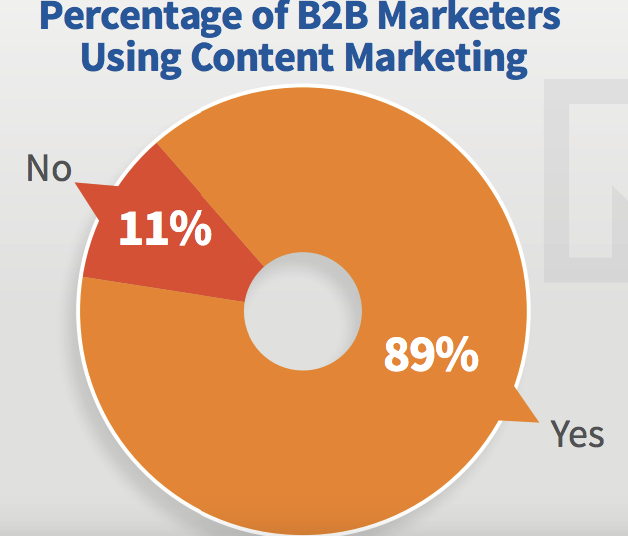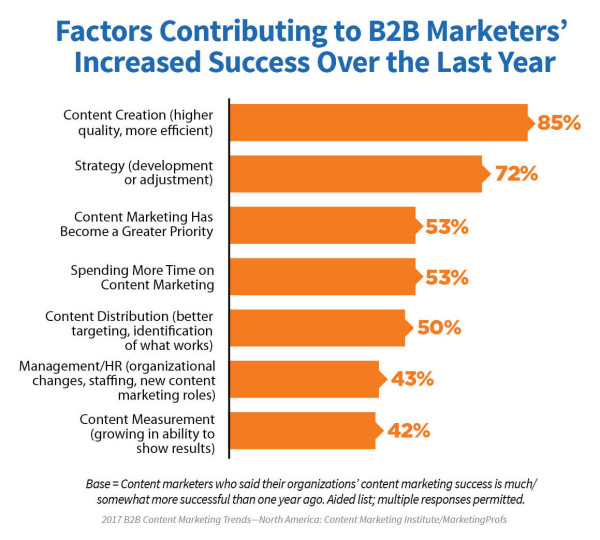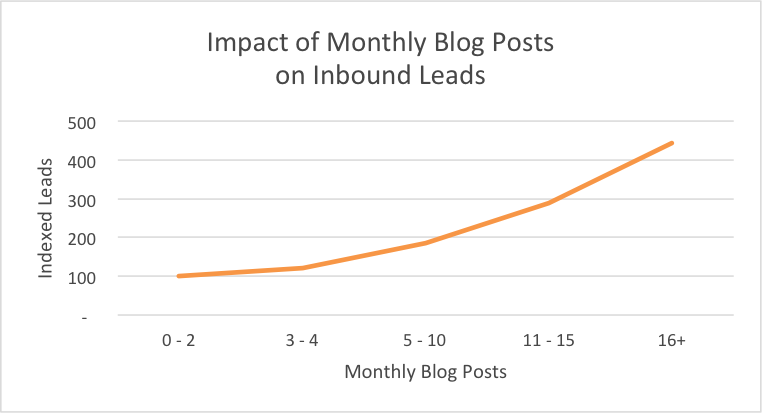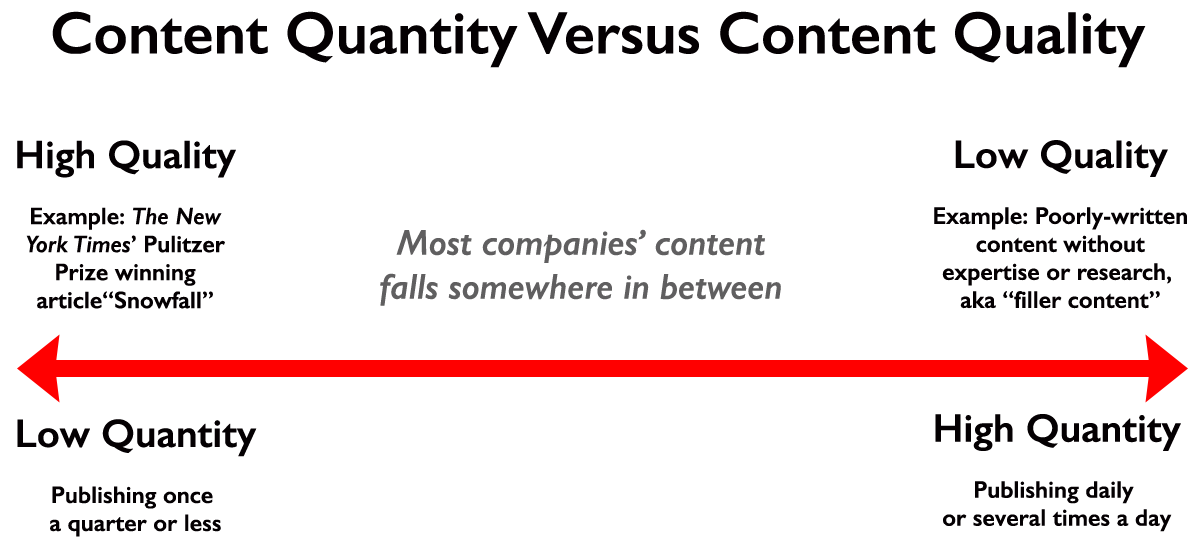6 Content Marketing Mistakes that Turn Your Audience Off Big-Time (And How to Avoid them)

When something grows in popularity as much as content marketing has in recent years, mistakes are bound to happen. There are a myriad of experts in content marketing, but even the best of them will sometimes make the wrong choice.
As a business owner or marketer, content marketing mistakes can cost you a lot. We are talking about missed opportunities, estranged audiences and even wasting money on content that doesn’t convert or bring in leads.
Let’s take a look at the big picture.
89% of B2B marketers use content marketing.
 Image via Content Marketing Institute
Image via Content Marketing Institute
In fact, most marketers credit content marketing for their increased success. This means they aren’t going to stop creating content any time soon.
 Image via Content Marketing Institute
Image via Content Marketing Institute
In fact, most marketers plan to increase their efforts in this area. What does this mean?
More content, of course!
You see, when you jump on a wagon just because it’s trendy, you leave a lot of room for mistakes. This is how content becomes a commodity.
I have always advocated for relevant, ROI-oriented content. A good content marketing strategy takes time to research, plan and execute flawlessly. If you simply start blogging because you have to, you shouldn’t expect results any time soon.
Want to invest in content that brings results aka CASH, along with brand awareness and authority? You’re in the right place! Check out our services and let’s talk!
I’m not planning to help you make zero content marketing mistakes. You probably will. Call them tests, learn from them and move on. Just like we did before learning how to convert blog readers into paying customers.
But there are some common content marketing mistakes you can avoid if you know of them.
Let’s take a look at the six most common ones:
6 Content Marketing Mistakes to Avoid at All Costs
I won’t lie: content marketing mistakes are easy to make. Too easy, in fact. Make too many of them and your readers won’t just ignore everything you post. They’ll become irritated and even despise your brand.
It’s incredibly hard to come back from that!
Here’s what you should avoid:
-
Stealing other People’s Content
First and foremost, this is illegal. Plagiarism and copyright infringement can easily land you in a court and even in jail. At the very least, you will be demoted by Google and pay hefty fines. And, of course, lose any brand authority and trust.
By the way, authority and trust are the number one things that content should help you build, not destroy.
I’m sure you know you shouldn’t copy someone else’s content. You can use definitions and small paragraphs, but be sure to reference them appropriately. Ideally, ask for permission in advance.
I won’t insist on this – it’s more of a legal matter than a copywriting mistake.
What I will insist on isn’t copying per se, but imitation.
You see, we all have that epiphany-meets-jealousy moment when we read an article and wished we would have written it ourselves. It’s effin’ brilliant, perfectly worded and it has already won a ton of social shares.
But we didn’t. Someone else did.
The first instinct is to write a very similar one. You wouldn’t be copying, so there’s no legal issue, right?
Right.
But…
But it’s not OK, either!
The article you loved was written in someone else’s voice, not your own. Your brand needs to have its own voice – this is why your readers are there, to read what you think and write, not re-hashed opinions from someone else.
Does this mean you have to come up with blog titles and topics no one has EVER tackled before? Of course not! In some industries, this would be impossible.
In fact, I’m pretty sure you already know this is not the first article on content marketing mistakes out there. There must be a few dozen if not hundreds of them already.
What makes mine unique? Why is it not plagiarism?
First off, I didn’t copy anything.
Secondly, it’s in my own voice.
Thirdly, it benefits from my own experience and knowledge. I am speaking about content marketing mistakes that I deem unforgettable and that I know will hurt your brand. My perspective, my voice and my very own content.
Oh, and of course, everything is properly referenced. D’oh!
-
Gimme Your Money! No Really, Pay Me! (Don’t Do This)
Yes, I’ve said it before – content with zero ROI is useless. You want your content to sell, generate leads or, at least, assist with selling.
But here’s the catch: if you write like a car salesman, your content will do neither. Of course you need to remind people that you’re selling something. Of course you have to brag a bit sometimes.
“A bit” and “sometimes” are the key here.
Authority content is helpful and informational above all else. It’s part of the inbound sales process. And the first rule of inbound sales is don’t be pushy!
The amazing Joanna Wiebe makes an excellent point about why you should never sell like a sleazy used car salesman.
Don’t be that guy. Instead, be the kind of guy who wins audience’s trust by working hard on content that is helpful and builds authority and trust.
Look at this article for instance. You’re reading it on the blog of a digital marketing agency – my agency, to be precise. I could tell you that I never-ever made any content marketing mistakes. And if you hire us, your content strategy and implementation will be flawless, too.
(We are skilled content writers, we could enlarge upon the last two sentences for more than 2,000 words.)
Instead, I chose to acknowledge my own mistakes and those of my team. More importantly, I didn’t shove our services in your phase. I wrote an article that I honestly think will help marketers and business owners avoid common content marketing mistakes.
What do I expect in return?
I expect you, the reader, to start trusting me. At least more than you would someone who shouts “We are the best!” without actual proof. You may not hire us right now, but I expect you to at least consider hiring Idunn when the time is right for you.
These expectations aren’t built on dreams and high hopes. 90% of our clients come because of our content. The rest are referrals. The same goes for a lot of our customers – we know for a fact authority content does sell – if you don’t push too hard.
-
Focusing on Yourself, not Your Readers
Any psychologist will tell you that being self-centered is going to ruin most of your relationship. You’d be surprised at how many things that are real in life have equivalents in business and marketing.
One of the biggest content marketing mistakes is forgetting whom you are writing for. It’s not for yourself. It’s for your readers and your (potential) customers.
I know it’s tempting to start writing from a point that you are familiar with. It’s also very tempting to address your own concerns and to brag.
The internet is still littered with websites that speak only of how great their owners are. “We have the best team who creates the best product for the best price.” Multiply that, add small variations to the copy and you’ve got yourself the content of the 90s.
Today’s websites, blogs and other content supports start with their customers’ pain points. They use “you” instead of “I” or “we”. They speak about their customers’ problems, not their need to get more clients.
User intent is the key to getting more users AND keeping them happy. Learn what your readers want, what they need, what problems they are facing and you will half way to winning their hearts.
The ideal formula is: pain point – solution – why us.
Of course, that’s a VERY simplified version of the formula. But the gist remains: start by showing you understand your customers’ problems. Offer the solution they’ve been waiting for. Only then you can explain why they should choose you and not your competitors.
-
Blogging More, not Better
“How often should I blog?” is a question I get from almost every client. You see, we offer content writing services, so I should answer “daily”, right?
I don’t.
There’s a famous HubSpot study that says companies that blog more than 16 times per month get 4.5 X times more leads than those that publish 0-4 times every month.
 Image via HubSpot
Image via HubSpot
So, should you blog 16+ times per month? Maybe. Maybe you should blog more and maybe you should blog less. The truth is that you never know until you’ve tried a few options.
As far as content marketing mistakes go, one of the most common ones is over flooding your audience with content. You think that more is better. Why wouldn’t it be?
Well, first of all because quality tends to decrease with quantity.
As always, balance is key. If you write just to meet a quota, you’ll get crappy content that no one wants to read.
 Image via Scoop.it
Image via Scoop.it
But hey, at least I’ll rank better in SERPs, right?
No, not even that! (And even if you would, who cares about organic traffic that brings no sales?)
Search engines have gotten smarter. They can spot quality content using a ton of metrics (engagement, number of readers, bounce rate and more). Consequently, they will know if you are producing great content or just a ton of meh-content.
Your readers, of course, will know, too. So do yourself a favor: write when you have something good to say, not X times per week or per month.
A content calendar is a great idea. Everyone should have one. But make sure to fill it with topics that are relevant, not just placeholders.
-
Not Measuring Your Efforts
When we onboard a new client at Idunn, we always ask about their current content marketing strategy. We are especially interested in what worked for them and what didn’t. Why repeat the same content marketing mistakes?
I am shocked to see very few people know what works. They spend thousands of dollars every month on content to which they cannot attribute a single sale.
This doesn’t mean that the content didn’t sell anything. It just means they can’t tell if it did.
We live in an era when we have unprecedented access to measuring tools. Start with Google Analytics to see what drove traffic. Add UTM parameters to see where do all the clicks on “Buy” or “Contact Us” come from.
Use tools like SEMrush (paid) or Google Webmaster Tools (free) to see how well your content does in SERPs. Use HubSpot to track on-page clicks or HotJar to see how people interact with every page of your website.
This list could go on FOREVER! I’m pretty sure that, as I’m writing this, new measuring and Analytics tools are being developed and launched.
Most of them offer free trials. Others are completely free. Test a few of them to see which one works best for you.
Then start tracking which of your blog posts, white papers and web pages are bringing in cash. You will also learn how to tweak the low-performing ones.
If all else fails, at least ask your customers how they learned about you. Yes – the oldest tracking “tool” known to marketers can save you from making new content marketing mistakes.
-
Overdoing the SEO (and Messing it All Up as a Consequence)
The era of keyword stuffing is thankfully gone. On-page SEO is more than repeating the same keyword ad nauseam.
The best running shoes are comfy and sturdy. If you buy the best running shoes you may end up paying more than for regular running shoes. But when you buy best running shoes on the market you will run better and be healthier.
Did reading that make you happy? Got you to want to buy the darn running shoes? Would you trust a brand writes like this?
I don’t think so.
Why would you?
It’s obviously spammy content. And spammy usually means scammy, too.
If you think that you can “hide” such copy where it’s not readable by human eyes, only search engine bots, think again. Google also penalizes spammy content, so there’s no good outcome when you write like spam bot.
What should you do instead?
Write naturally. Write as if you spoke to a friend, someone you care for. Sure, do your keyword research and add your keyword in all the relevant places. But never, ever go for a density above 1%.
And, more importantly, never sacrifice readability for the sake of SEO.
I’ve said it before: if your readers love your content, so will search engines. So optimize for humans, not bots.
Conclusions
The best thing to do to avoid the worst content marketing mistakes is to stay true to your brand and to your readers. Be honest. Write helpful content that solves real problems (not yours!).
Reference appropriately. Be straightforward and skip the sleazy sales pitch. In other words: treat your readers as you yourself like to be treated online. No bullying, no false promises and no bragging.
If you want to up your content marketing game, we’re happy to help! Our team of skilled writers can help you with content that gets you readers, rankin


6 Comentarii la “6 Content Marketing Mistakes that Turn Your Audience Off Big-Time (And How to Avoid them)”
[…] of the biggest content marketing mistakes is assuming that your customers are all at the same stage. Typically, a marketer or business owner […]
[…] of many greatest content marketing mistakes is assuming that your prospects are all on the identical stage. Sometimes, a marketer or enterprise […]
[…] of the biggest content marketing mistakes is assuming that your customers are all at the same stage. Typically, a marketer or business owner […]
[…] of the biggest content marketing mistakes is assuming that your customers are all at the same stage. Typically, a marketer or business owner […]
#5 is KEY and often overlooked. Content is an investment. You must monitor, measure, and improve your existing content over time.
Indeed! So easy and yet so often overlooked.